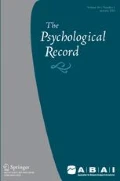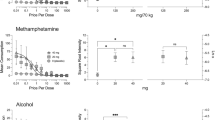Abstract
Advances in behavioral economic research methodology have generated novel insights into public policy considerations regarding substance use and addiction. A major advancement toward this end was the development of hypothetical purchase tasks (HPTs) that permit modeling of consumption and demand without the need for actual purchases and lengthy human operant studies comprised of real reward deliveries. Psychometric research in the domain of behavioral pharmacology suggests that the HPT has adequate test–retest reliability, as well as construct and convergent/divergent validity. Research to date has exclusively examined pharmacological commodities, however, necessitating the need for technology transfer to other pressing societal issues. In the present study, we examined demand for recreational driving across three groups, each consisting of a different fuel price progression size in the HPT. Findings suggest that behavioral economic models of demand do not differ as a function of progression size, providing support to the inter-method reliability of this procedure.




Similar content being viewed by others
References
Bickel, W. K., DeGrandpre, R. J., & Higgins, S. T. (1993). Behavioral economics: a novel experimental approach to the study of drug dependence. Drug and Alcohol Dependence, 33, 173–192. doi:10.1016/0376-8716(93)90059-Y.
Bickel, W. K., Jarmolowicz, D. P., MacKillop, J., Epstein, L. H., Carr, K., Mueller, E. T., & Waltz, T. J. (2012). The behavioral economics of reinforcement pathologies: Novel approaches to addictive disorders. In H. J. Shaffer (Ed.), APA addiction syndrome handbook. Washington: APA Books.
Brownell, K. D., & Frieden, T. R. (2009). Ounces of prevention—the public policy case for taxes on sugared beverages. New England Journal of Medicine, 360, 1805–1808. doi:10.1056/NEJMp0902392.
Carter, B. L., & Tiffany, S. T. (1999). Meta-analysis of cue-reactivity in addiction research. Addiction, 94, 327–340. doi:10.1046/j.1360-0443.1999.9433273.x.
Collins, R. L., Parks, G. A., & Marlatt, G. A. (1985). Social determinants of alcohol consumption: the effects of social interaction and model status on the self-administration of alcohol. Journal of Consulting and Clinical Psychology, 53, 189–200. doi:10.1037/0022-006X.53.2.189.
Few, L. R., Acker, J., Murphy, C., & MacKillop, J. (2012). Temporal stability of a cigarette purchase task. Nicotine & Tobacco Research, 14, 761–765. doi:10.1093/Ntr/Ntr222.
Green, L., & Freed, D. E. (1993). The substitutability of reinforcers. Journal of the Experimental Analysis of Behavior, 60, 141–158. doi:10.1901/jeab.1993.60-141.
Havranek, T., Irsova, Z., & Janda, K. (2012). Demand for gasoline is more price-inelastic than commonly thought. Energy Economics, 34, 201–207. doi:10.1016/j.eneco.2011.09.003.
Hursh, S. R. (1980). Economic concepts for the analysis of behavior. Journal of the Experimental Analysis of Behavior, 34, 219–238. doi:10.1901/jeab.1980.34-219.
Hursh, S. R. (1984). Behavioral economics. Journal of the Experimental Analysis of Behavior, 42, 435–452. doi:10.1901/jeab.1984.42-435.
Hursh, S. R. (in press). Behavioral economics and the analysis of consumption and choice. In F. K. McSweeney& E. S. Murphy (Eds.), Wiley-Blackwell handbook of operant and classical conditioning. Oxford: Wiley-Blackwell.
Hursh, S. R., & Roma, P. G. (2013). Behavioral economics and empirical public policy. Journal of the Experimental Analysis of Behavior, 99, 98–124. doi:10.1007/s00213-008-1120-0.
Hursh, S. R., & Silberberg, A. (2008). Economic demand and essential value. Psychological Review, 115, 186–198. doi:10.1037/0033-295x115.1.186.
Hursh, S. R., & Winger, G. (1995). Normalized demand for drugs and other reinforcers. Journal of the Experimental Analysis of Behavior, 64, 373–384. doi:10.1901/jeab.1995.64-373.
Hursh, S. R., Raslear, T. G., Shurtleff, D., Bauman, R., & Simmons, L. (1988). A cost-benefit-analysis of demand for food. Journal of the Experimental Analysis of Behavior, 50, 419–440. doi:10.1901/jeab.1988.50-419.
Hursh, S. R., Raslear, T. G., Bauman, R., & Black, H. (1989). The quantitative analysis of economic behavior with laboratory animals. In K. G. Grunert & F. Olander (Eds.), Understanding economic behavior (pp. 117–165). New York: Kluwer Academic Publishers, Theory and Decision Library.
Hursh, S. R., Madden, G. J., Spiga, R., DeLeon, I. G., & Francisco, M. T. (2012). The translational utility of behavioral economics: The experimental analysis of consumption and choice. Washington: American Psychological Association.
Jacobs, E. A., & Bickel, W. K. (1999). Modeling drug consumption in the clinic using simulation procedures: demand for heroin and cigarettes in opioid-dependent outpatients. Experimental and Clinical Psychopharmacology, 7, 412–426. doi:10.1037/1064-1297.7.4.412.
Jain, N., Rademaker, A., & Robinson, J. K. (2012). Implementation of the federal excise tax on indoor tanning services in Illinois. Archives of Dermatology, 148, 122–124. doi:10.1001/archderm.148.1.122.
Johnson, M. W., & Bickel, W. K. (2006). Replacing relative reinforcing efficacy with behavioral economic demand curves. Journal of the Experimental Analysis of Behavior, 85, 73–93. doi:10.1901/jeab.2006.102-04.
Ko, M. C., Terner, J., Hursh, S., Woods, J. H., & Winger, G. (2002). Relative reinforcing effects of three opioids with different durations of action. Journal of Pharmacology and Experimental Therapeutics, 301, 698–704. doi:10.1124/jpet.301.2.698.
Laibson, D. (2001). A cue-theory of consumption. Quarterly Journal of Economics, 116, 81–119. doi:10.1162/003355301556356.
MacKillop, J., & Murphy, J. G. (2007). A behavioral economic measure of demand for alcohol predicts brief intervention outcomes. Drug and Alcohol Dependence, 89, 227–233. doi:10.1016/j.drugalcdep.2007.01.002.
MacKillop, J., Murphy, J. G., Ray, L. A., Eisenberg, D. T. A., Lisman, S. A., Lum, J. K., & Wilson, D. S. (2008). Further validation of a cigarette purchase task for assessing the relative reinforcing efficacy of nicotine in college smokers. Experimental and Clinical Psychopharmacology, 16, 57–65. doi:10.1037/1064-1297.16.1.57.
MacKillop, J., O'Hagen, S., Lisman, S. A., Murphy, J. G., Ray, L. A., Tidey, J. W., & Monti, P. M. (2010). Behavioral economic analysis of cue-elicited craving for alcohol. Addiction, 105, 1599–1607. doi:10.1111/j.1360-0443.2010.03004.x.
MacKillop, J., Brown, C. L., Stojek, M. K., Murphy, C. M., Sweet, L., & Niaura, R. S. (2012a). Behavioral economic analysis of withdrawal- and cue-elicited craving for tobacco: an initial investigation. Nicotine & Tobacco Research, 14, 1426–1434. doi:10.1093/Ntr/Nts006.
MacKillop, J., Few, L. R., Murphy, J. G., Wier, L. M., Acker, J., Murphy, C., & Chaloupka, F. (2012b). High-resolution behavioral economic analysis of cigarette demand to inform tax policy. Addiction, 107, 2191–2200. doi:10.1111/j.1360-0443.2012.03991.x.
Madden, G. J., & Hartman, E. C. (2006). A steady-state test of the demand curve analysis of relative reinforcer efficacy. Experimental and Clinical Psychopharmacology, 14, 79–86. doi:10.1037/1064-1297.14.1.79.
Madden, G. J., & Kalman, D. (2010). Effects of bupropion on simulated demand for cigarettes and the subjective effects of smoking. Nicotine & Tobacco Research, 12, 416–422. doi:10.1093/Ntr/Ntq018.
Murphy, J. G., & MacKillop, J. (2006). Relative reinforcing efficacy of alcohol among college student drinkers. Experimental and Clinical Psychopharmacology, 14, 219–227. doi:10.1037/1064-1397.14.2.219.
Murphy, J. G., MacKillop, J., Skidmore, J. R., & Pederson, A. A. (2009). Reliability and validity of a demand curve measure of alcohol reinforcement. Experimental and Clinical Psychopharmacology, 17, 396–404. doi:10.1037/a0017684.
Murphy, J. G., MacKillop, J., Tidey, J. W., Brazil, L. A., & Colby, S. M. (2011). Validity of a demand curve measure of nicotine reinforcement with adolescent smokers. Drug and Alcohol Dependence, 113, 207–214. doi:10.1016/j.drugalcdep.2010.08.004.
Patient Protection and Affordable Care Act, Pub. L. No. 111-148, §2702, 124 Stat. 119, 318–319 (2010).
Powell, L. M., Chriqui, J., & Chaloupka, F. J. (2009). Associations between state-level soda taxes and adolescent body mass index. Journal of Adolescent Health, 45, S57–S63. doi:10.1016/j.jadohealth.2009.03.003.
Pritchard, J. (2010). Virtual rewards for driving green. Behavior Analyst, 33, 185–187.
Rachlin, H., Green, L., Kagel, J. H., & Battalio, R. C. (1976). Economic demand theory and psychological studies of choice. In G. Bower (Ed.), The psychology of learning and motivation (vol. 10, pp. 129–154). New York, NY: Academic Press.
Reed, D. D., Luiselli, J. K., Magnuson, J. D., Fillers, S., Vieira, S., & Rue, H. C. (2009). A comparison between traditional economical and demand curve analyses of relative reinforcer efficacy in the validation of preference assessment predictions. Developmental Neurorehabilitation, 12, 164–169. doi:10.1080/17518420902858983.
Reed, D. D., Niileksela, C., & Kaplan, B. A. (2013a). Behavioral economics: a tutorial for behavior analysts in practice. Behavior Analysis in Practice, 6, 34–54.
Reed, D. D., Partington, S. W., Kaplan, B. A., Roma, P., & Hursh, S. (2013b). Behavioral economic analyses of demand for fuel in North American transportation. Journal of Applied Behavior Analysis, 46, 651–655. doi:10.1002/jaba.64.
Roane, H. S., Lerman, D. C., & Vorndran, C. M. (2001). Assessing reinforcers under progressive schedule requirements. Journal of Applied Behavior Analysis, 34, 145–166. doi:10.1901/jaba.2001.34-145.
Shafir, E. (2013). The behavioral foundations of public policy. Princeton: Princeton University Press.
Shahan, T. A., Bickel, W. K., Madden, G. J., & Badger, G. J. (1999). Comparing the reinforcing efficacy of nicotine containing and de-nicotinized cigarettes: a behavioral economic analysis. Psychopharmacology, 147, 210–216. doi:10.1007/s002130051162.
Spiga, R., Martinetti, M. P., Meisch, R. A., Cowan, K., & Hursh, S. (2005). Methadone and nicotine self-administration in humans: a behavioral economic analysis. Psychopharmacology, 178, 223–231. doi:10.1007/s00213-004-2020-6.
Sturm, R., Powell, L. M., Chriqui, J. F., & Chaloupka, F. J. (2010). Soda taxes, soft drink consumption, and children’s body mass index. Health Affairs, 29, 1052–1058. doi:10.1377/hlthaff.2009.0061.
Thaler, R. H., & Sunstein, C. R. (2008). Nudge: Improving decisions about health, wealth, and happiness. New Haven: Yale University Press.
White, H. R., & Labouvie, E. W. (1989). Towards the assessment of adolescent problem drinking. Journal of Studies on Alcohol, 50, 30–37.
Williams, S. N. (2012). A tax on indoor tanning would reduce demand in europe. British Medical Journal, 345, e6550. doi:10.1136/bmj.e6550.
Author information
Authors and Affiliations
Corresponding author
Rights and permissions
About this article
Cite this article
Reed, D.D., Kaplan, B.A., Roma, P.G. et al. Inter-Method Reliability of Progression Sizes in a Hypothetical Purchase Task: Implications for Empirical Public Policy. Psychol Rec 64, 671–679 (2014). https://doi.org/10.1007/s40732-014-0076-1
Published:
Issue Date:
DOI: https://doi.org/10.1007/s40732-014-0076-1




